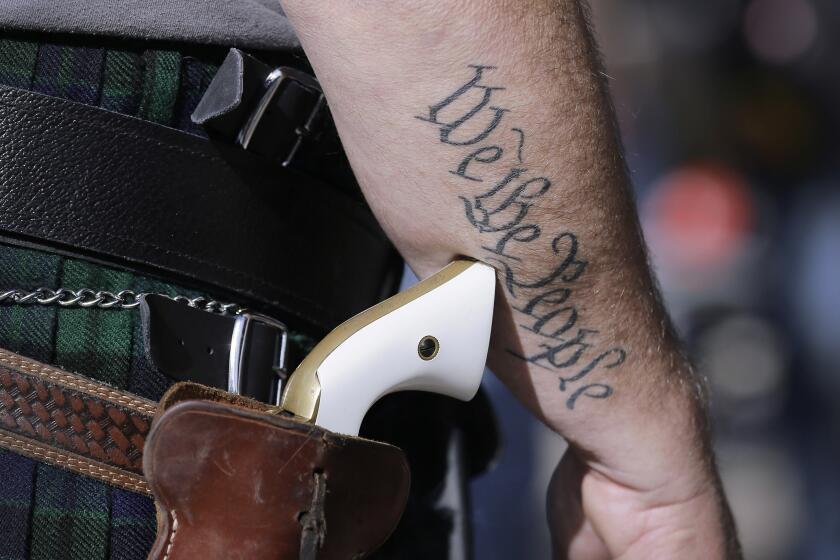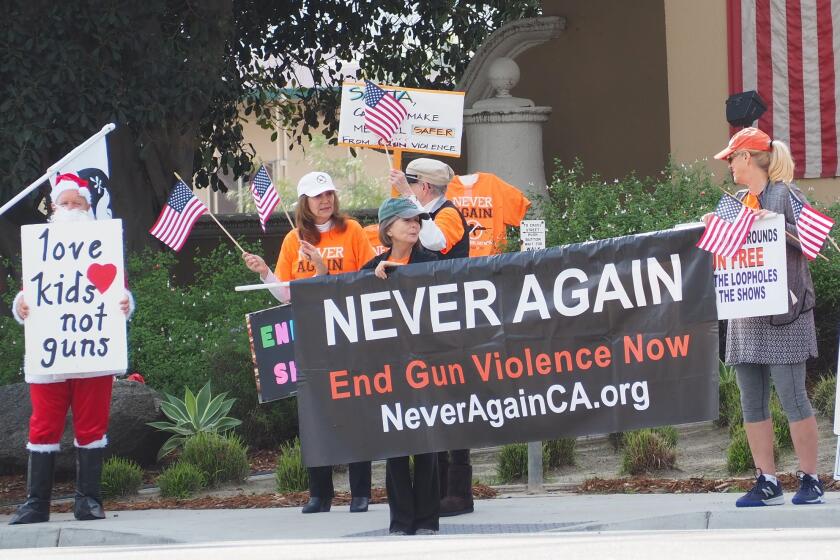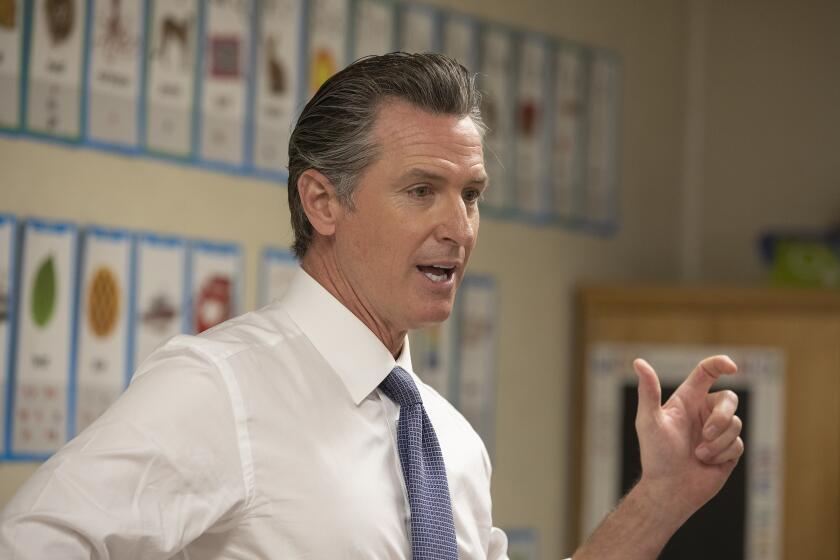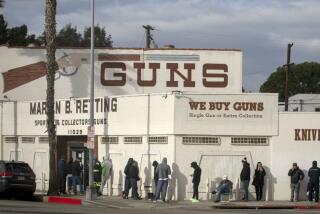California opens the door to suing gun makers. Here’s what the new law does

- Share via
Three weeks after the U.S. Supreme Court struck down tough state controls on concealed weapon licenses, California Gov. Gavin Newsom signed into law an effort to limit the availability of “abnormally dangerous” guns in the state.
The law, AB 1594 by Assemblyman Phil Ting (D-San Francisco), requires manufacturers, distributors and dealers of guns and ammunition to abide by new state standards for the safety, marketing and sale of their products. Patterned after a similar law in New York, the measure empowers the state, local governments and individuals harmed by gun violence to sue companies that violate those standards.
The point is to impose the same sort of liability on the firearms industry that other manufacturers and retailers routinely face, said Tanya Schardt of the Brady gun-control advocacy group, which co-sponsored the bill with California Atty. Gen. Rob Bonta.
“Right now, the gun industry is exclusively insulated from liability for dangerous, irresponsible or negligent business practices,” Schardt said. “This is just making sure the gun industry is not insulated in ways that every other industry is not.”
The measure could erect a barrier to at least some types of assault weapons in the state, as well as pressuring manufacturers and dealers to rein in illicit sales and promote safer products. But it is sure to be challenged in court by gun-rights advocates, who say it would lead manufacturers to stop doing business in California.
Rick Travis, legislative director for the California Rifle and Pistol Assn., said his group has been a longtime advocate for gun safety and for getting guns out of the hands of criminals. But AB 1594, like the vast majority of California’s gun control efforts, goes after law-abiding people, not criminals, Travis said.
Now that the Supreme Court has tossed out a New York law limiting who can get a permit to carry a gun, California’s rules are on shaky legal ground.
Here’s a summary of what the law requires, along with arguments in favor and against it.
New state standards
The heart of the law is new “standards of conduct” for the companies making and selling guns, ammunition, parts and accessories in California. Under those standards, companies have to put “reasonable controls” in place to guard against improper sales, such as those to straw purchasers, gun traffickers and people who present a “substantial risk” of using the product unlawfully or to harm themselves or others.
Such controls are also required to guard against the loss or theft of gun-related products from wholesalers and retailers. In addition, manufacturers and dealers have to “not otherwise promote the unlawful manufacture, sale, possession, marketing or use of a firearm-related product.”
The main goal of those provisions, Schardt said, is to deter manufacturers from supplying the fraction of dealers responsible for selling the vast majority of guns used in crimes. According to a 2000 study by the Bureau of Alcohol, Tobacco Firearms and Explosives, almost 90% of the firearms recovered by law enforcement officials were traced back to 7% of gun dealers and pawnbrokers. (More recent data isn’t available because of a 2003 federal law barring the feds from sharing these statistics with the public.)
Other provisions of the law bar the manufacture, marketing, importation or sale of firearm-related products that are “abnormally dangerous”; that is, deadly beyond their “inherent capacity to cause injury or lethal harm.” The measure defines “abnormally dangerous” as having “features that render the product most suitable for assaultive purposes” instead of hunting or self-protection; being designed or marketed in a way that “foreseeably” promotes conversion into automatic weapons or other illegal products; or being designed and promoted in a way that targets minors or people who can’t legally possess firearms.
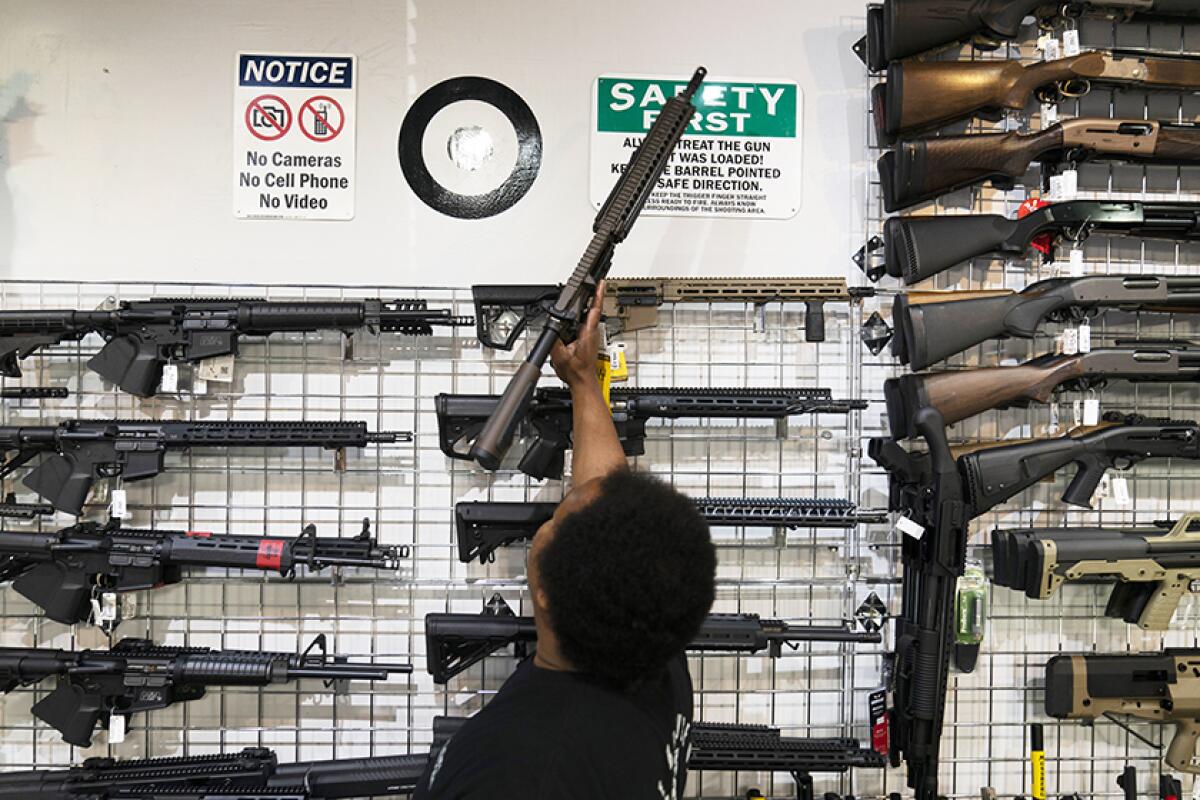
The state already bans the sale of assault weapons to adults and to people under 21 years old, as well as the sale of high-capacity magazines, but those restrictions are in legal jeopardy. The “abnormally dangerous” standard could run afoul of the same constitutional arguments, but Schardt noted that California has long prohibited handguns that don’t meet its design safety standards.
The new law, she said, will give manufacturers and dealers an incentive to shift to firearms with more safety features, such as trigger locks to prevent unintended shootings and microstamping technology to identify guns used in crimes. “There are ways to make guns safer,” she said.
Finally, the statute brings the gun industry under a number of state consumer protection and competition laws, including strictures against false and misleading advertising or deceptive claims about the product being sold.
The law is set to go into effect July 1, 2023.
Newsom signs several new gun restrictions into law, just weeks after the Supreme Court bolstered the rights of firearms owners.
How the law would be enforced
AB 1594 is designed to be enforced through lawsuits — not just by the state attorney general but also by attorneys for city and county governments and by anyone “who has suffered harm as a result of the violation.” For example, the family of someone shot by a person wielding a military-style rifle could sue the manufacturer and the seller of the weapon, alleging that it was “abnormally dangerous.”
That claim wouldn’t necessarily be blocked by the “criminal misuse” of the firearm, the law states. If the plaintiffs win their case, a court could impose an injunction against the defendant and award damages, attorney fees and costs, as well as “any other appropriate relief necessary to ... remedy the harm caused by the conduct.”
AB 1594 responds to Newsom’s call for a measure that would empower ordinary Californians to sue gun manufacturers and dealers that bring assault weapons into the state. The governor was taking a page from a Texas law that encourages residents there to sue people who help a woman obtain an abortion. The use of bounties and citizen lawsuits was Texas’ way of getting around Roe vs. Wade, a decision the Supreme Court has since overturned.
Legal hurdles
The National Rifle Assn. opposed AB 1594 as it was moving through the Legislature, arguing that the state was trying to drive out gun makers and dealers with “frivolous litigation.” It also argued that the provisions were overly vague, saying in a letter to lawmakers, “The term ‘reasonable controls’ is not defined as conforming to a specific set of measures or regulations.”
More fundamentally, Travis of the California Rifle and Pistol Assn. noted, a 2005 federal law, the Protection of Lawful Commerce in Arms Act, bars state and federal lawsuits against gun manufacturers and dealers for the unlawful use or misuse of their products by third parties.
The proposed law would let California citizens sue gun manufacturers, similar to how Texas has made it easier for its residents to sue abortion providers.
He cited this passage from the PLCAA’s findings: “The possibility of imposing liability on an entire industry for harm that is solely caused by others is an abuse of the legal system, erodes public confidence in our Nation’s laws, threatens the diminution of a basic constitutional right and civil liberty, invites the disassembly and destabilization of other industries and economic sectors lawfully competing in the free enterprise system of the United States, and constitutes an unreasonable burden on interstate and foreign commerce of the United States.”
The PLCAA includes an exception, however, for lawsuits against manufacturers and dealers that “knowingly violated a State or Federal statute applicable to the sale or marketing of the product, and the violation was a proximate cause of the harm for which relief is sought.” Supporters of the new state law say the liability it imposes fits into that exception.
“In 2005, the federal government stripped Americans of the right to hold gun manufacturers and distributors responsible for the damage their conduct causes when their products are used unlawfully — leaving only a narrow exception for such lawsuits,” Bonta wrote to lawmakers. “[U]sing that exception, we begin the process of restoring these rights in California.”
The Supreme Court, meanwhile, made clear its expansive view of 2nd Amendment rights when it threw out New York’s restrictions on concealed weapons licenses last month. After handing down the decision in New York State Rifle & Pistol Assn. vs. Bruen, the court called on appellate courts to reconsider a number of other state gun laws, including California’s restriction on high-capacity magazines, Travis said.
AB 1594 interferes with 2nd Amendment rights, Travis said, because the threat of liability discourages gun manufacturers from making legal products available to Californians. Worse, he said, gun owners could lose access to the parts they need to maintain safe weapons, as well as the safety materials that gun manufacturers offer.
While the state keeps going after gun manufacturers, Travis said, people die every weekend in wrecks caused by drunk drivers. “And yet are we suing the liquor makers? Nope. Are we suing Ford? No.”
Schardt said she expects AB 1594 to be challenged in court but noted that a similar law in New York survived an initial court challenge. That case is under appeal.
The Supreme Court’s decision in Bruen, she contended, isn’t applicable to the new California law because the law doesn’t affect anyone’s ability to carry a gun. Besides, she said, it’s not credible to argue that guns will be less available as a consequence of the new liability rules. The PLCAA wasn’t enacted until 2005, she said, and “prior to that, people had no problem getting their guns.”
“The reality is most of the time, manufacturers and dealers, they are acting responsibly,” Schardt said. “We know there’s a small sliver of time when they’re not,” and that’s when “victims should be able to get accountability.”
About The Times Utility Journalism Team
This article is from The Times’ Utility Journalism Team. Our mission is to be essential to the lives of Southern Californians by publishing information that solves problems, answers questions and helps with decision making. We serve audiences in and around Los Angeles — including current Times subscribers and diverse communities that haven’t historically had their needs met by our coverage.
How can we be useful to you and your community? Email utility (at) latimes.com or one of our journalists: Jon Healey, Ada Tseng, Jessica Roy and Karen Garcia.
More to Read
Sign up for Essential California
The most important California stories and recommendations in your inbox every morning.
You may occasionally receive promotional content from the Los Angeles Times.
